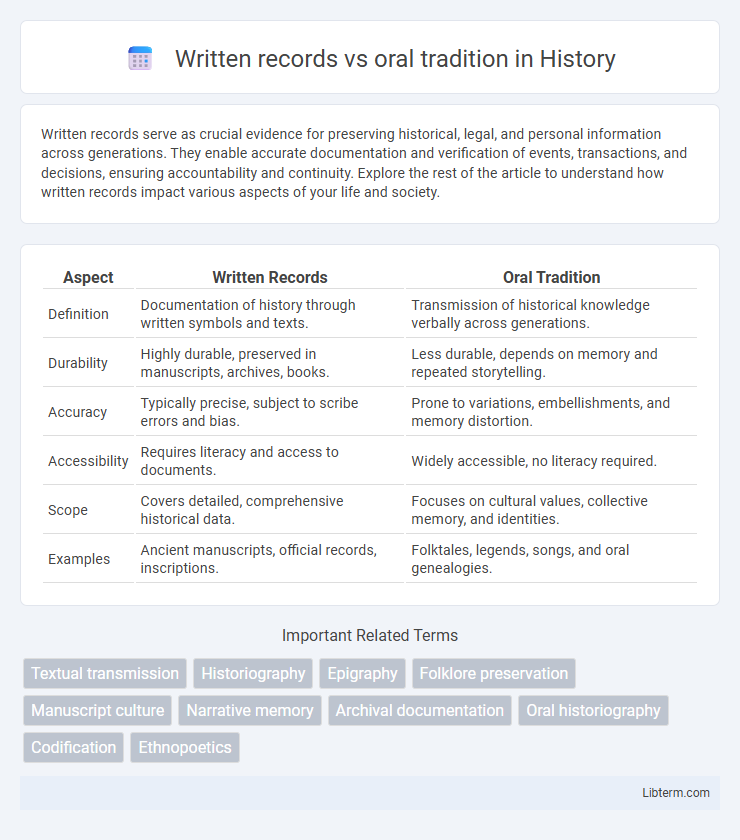Written records serve as crucial evidence for preserving historical, legal, and personal information across generations. They enable accurate documentation and verification of events, transactions, and decisions, ensuring accountability and continuity. Explore the rest of the article to understand how written records impact various aspects of your life and society.
Table of Comparison
| Aspect | Written Records | Oral Tradition |
|---|---|---|
| Definition | Documentation of history through written symbols and texts. | Transmission of historical knowledge verbally across generations. |
| Durability | Highly durable, preserved in manuscripts, archives, books. | Less durable, depends on memory and repeated storytelling. |
| Accuracy | Typically precise, subject to scribe errors and bias. | Prone to variations, embellishments, and memory distortion. |
| Accessibility | Requires literacy and access to documents. | Widely accessible, no literacy required. |
| Scope | Covers detailed, comprehensive historical data. | Focuses on cultural values, collective memory, and identities. |
| Examples | Ancient manuscripts, official records, inscriptions. | Folktales, legends, songs, and oral genealogies. |
Defining Written Records and Oral Tradition
Written records consist of documented information preserved through texts, inscriptions, and manuscripts, providing permanent, verifiable accounts of history, culture, and events. Oral tradition relies on spoken word, storytelling, and memory to transmit cultural knowledge, beliefs, and customs across generations without written documentation. The primary distinction lies in the medium of preservation and transmission, where written records offer fixed references, while oral tradition depends on human recollection and communal sharing.
Historical Development of Both Mediums
Written records emerged around 3200 BCE in Mesopotamia, marking a crucial advancement in preserving detailed historical data, laws, and economic transactions through durable materials like clay tablets and papyrus. Oral tradition predates writing, relying on storytelling, songs, and rituals to transmit cultural knowledge across generations, especially in societies without formal writing systems. Over time, written records facilitated complex administrative states and scholarly work, while oral traditions maintained flexibility, community engagement, and adaptability in historical storytelling.
Reliability and Accuracy: A Comparative Analysis
Written records provide a more reliable and accurate means of preserving information due to their permanence and ability to be reviewed and cross-verified over time. Oral tradition, while rich in cultural context and adaptability, is subject to memory distortion, interpretative changes, and loss of details across generations. The comparative analysis highlights that written documentation reduces errors and enhances consistency, whereas oral transmission depends heavily on the skill and fidelity of the storyteller.
Accessibility and Preservation Challenges
Written records offer greater accessibility as they can be easily replicated, archived, and disseminated across digital and physical platforms, enabling long-term preservation and wide-reaching study. Oral traditions face preservation challenges due to their reliance on human memory, vulnerability to alteration over generations, and limited distribution beyond immediate communities. Digital technology and audio recording methods help mitigate some accessibility issues in oral traditions but cannot fully replicate the permanence and consistency of written documentation.
Role in Shaping Collective Memory
Written records provide a fixed, verifiable account of historical events that helps preserve accuracy and continuity across generations, while oral tradition offers a dynamic, adaptable narrative shaped by communal values and contemporary contexts. The role of written records in shaping collective memory is anchored in their ability to standardize and archive information, ensuring long-term accessibility and reference. Oral tradition, conversely, fosters a living memory that reflects cultural identity and emotional resonance through storytelling, music, and rituals, reinforcing social cohesion within communities.
Transmission Across Generations
Written records ensure accurate transmission across generations by preserving information in fixed, durable formats like manuscripts, books, and digital archives. Oral tradition relies on memory, storytelling, and communal participation, which can lead to variations but also allows adaptability and cultural expression. Both methods serve crucial roles in maintaining historical knowledge, with written records providing stability and oral traditions fostering dynamic cultural continuity.
Cultural Significance and Identity
Written records preserve cultural heritage with precision, enabling societies to maintain historical accuracy and transmit identity across generations. Oral traditions embody living histories, fostering communal bonds and cultural resilience through storytelling and verbal transmission. Both forms crucially shape collective memory and identity, enriching cultural diversity and continuity worldwide.
Technological Influences on Record Keeping
Technological advancements such as the invention of the printing press and digital storage systems have dramatically transformed record keeping, enabling more accurate, durable, and accessible written records compared to oral tradition. Written records benefit from technologies like cloud databases and blockchain, which enhance data preservation and authenticity, while oral tradition relies on human memory and tends to be more susceptible to distortion over time. The transition from oral to written record systems reflects the increasing importance of technology in preserving historical, cultural, and legal information with greater precision and longevity.
Case Studies: Societies Relying on Each Method
Ancient Mesopotamia exemplifies societies relying on written records, where cuneiform tablets preserved legal codes, economic transactions, and religious texts, enabling complex administrative systems. In contrast, the Indigenous Australian communities demonstrate oral tradition's effectiveness, using storytelling and songlines to transmit cultural knowledge, history, and navigation skills across generations without a written script. These case studies highlight how written records facilitate bureaucratic control while oral traditions prioritize communal memory and adaptability.
The Future of Knowledge Transmission
Written records ensure precise preservation of complex information across generations, enabling widespread access and efficient retrieval of historical, scientific, and cultural data. Oral tradition fosters communal memory and adaptability, promoting nuanced storytelling and cultural continuity through dynamic interaction and personal engagement. Emerging technologies like blockchain and AI-enhanced storytelling hybridize written and oral methods, shaping the future of knowledge transmission toward greater authenticity, accessibility, and interactivity.
Written records Infographic

 libterm.com
libterm.com